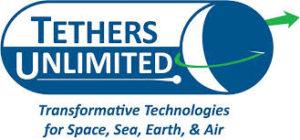Tethers Unlimited is a U.S. private aerospace company with its headquarters in Bothell, Washington. They carry out research and development of new products and technologies for space, sea, and air. TU was founded in 1994 to research and develop space tether technology. Applications of space tethers include removal of orbital debris and momentum exchange tethers for moving payloads to higher orbits. Space tethers enjoyed a brief popularity in the space industry community, but interest has fallen off since the 1990s.
In order to survive, TU branched out into other space technologies including power propulsion, actuation and communications for small satellites, robotic technologies for orbital fabrication and assembly, optical fiber winding and deployment, software defined radio communication and 3D printed radiation shielding.
In December of 2018, TU delivered a 3D printer to the International Space Station for testing. Firmamentum, a division of TU, is currently working on its “Spiderfab” technology to “enable on-orbit fabrication of large spacecraft components such as antennas, solar panels, trusses, and other multifunctional structures.”
TU has developed the SWIFT-SLX software defined radio system. U. S. satellites must be assigned frequencies by a federal agency before launch. The conventional approach has been to insert a frequency specific crystal in the radio once the frequency has been assigned. A big problem with this approach has been that the frequency assignment process runs parallel to the construction of the satellite and sometimes, the frequency is not assigned until the last moment. This means that the engineers have to open up the satellite and insert the frequency chip just before launch which is risky.
The SWIFT-SLX takes a different approach. The operating frequency of the radio is determined by onboard software. This means the frequency can be easily set any time before the satellite is launched. It can also be changed after launch while the satellite is in orbit.
The SWIFT-SLX is designed to fit within a cubesat satellite. Cubesats are based on a unit cube four inches on a side and are launched as secondary payloads with big satellites. The SWIFT-SLX can be configured for a variety of mission needs. It can adjust operating frequencies in the S and L band communication channels while in orbit. The development of the SWIFT-SLX was aided by Small Business Innovation Research grants from the Air Force Research Laboratory and the Army Space and Missile Defense Center.
TU has just announced a successful test of two-way radio communication between the Earth and an orbiting satellite carried out by the TU SWIFT-SLX radio. The test allowed communication between Harris Corporation’s first small satellite, the HSAT-1, and satellite ground control. The HSAT was launched last November by India’s Polar Satellite Launch Vehicle.
Rob Hoyt is the CEO of TU. He said, “Our team has worked very hard to bring the SWIFT radios to the level of maturity and quality necessary to meet the needs of top-tier customers such as Harris Corp. The great performance of the SWIFT-SLX right out of the gate is a big testament to our SWIFT team’s efforts and the collaborative support of the Harris integration team.”
